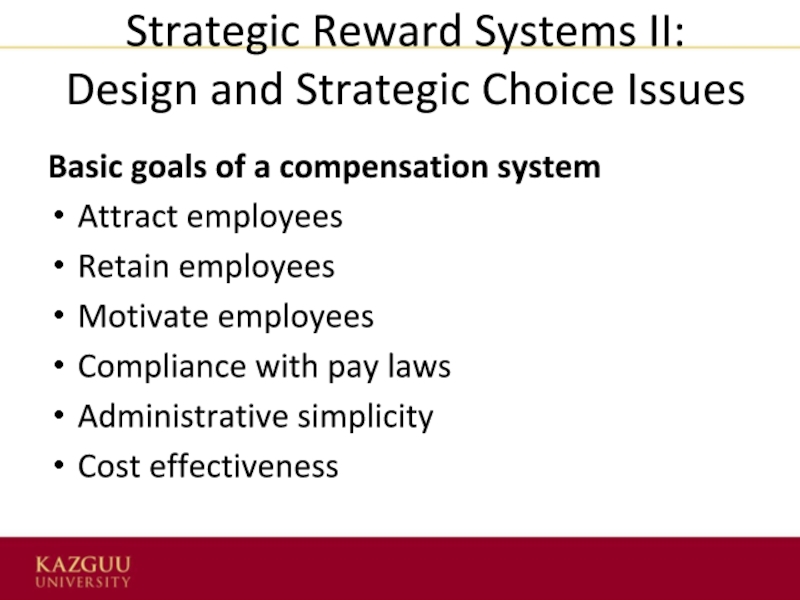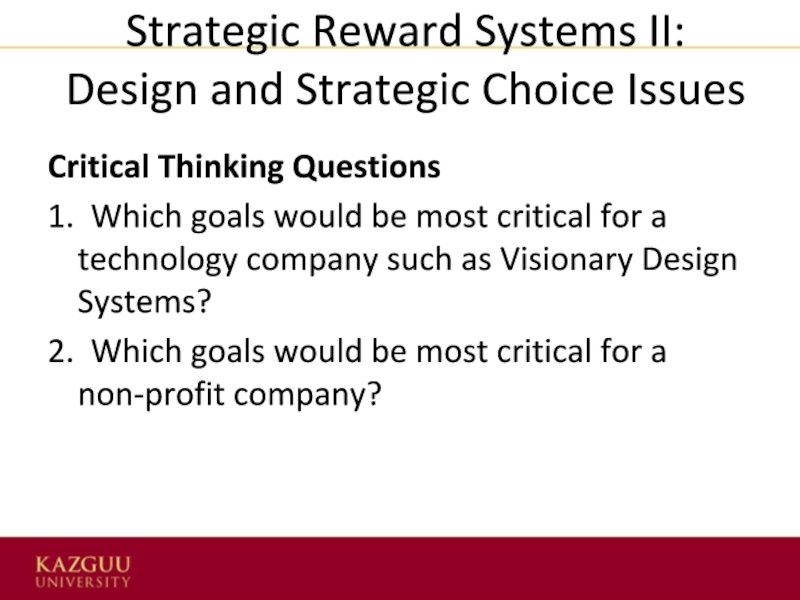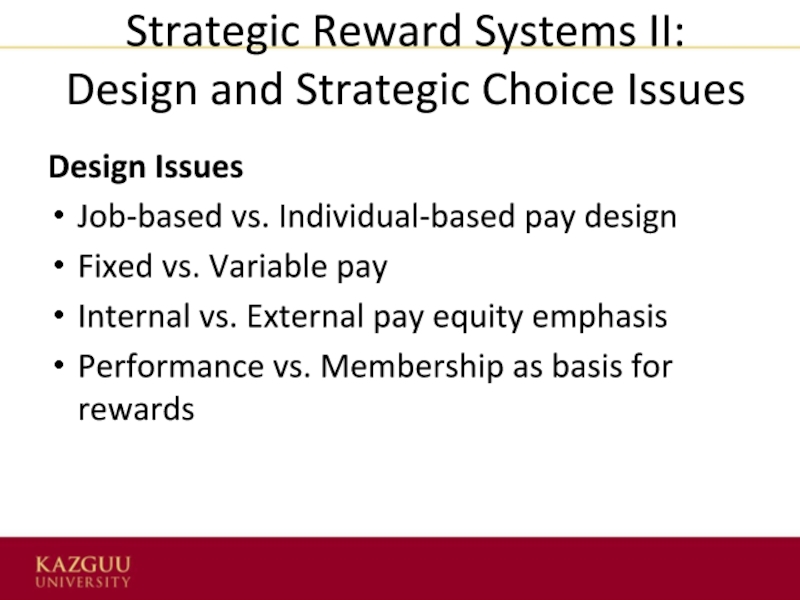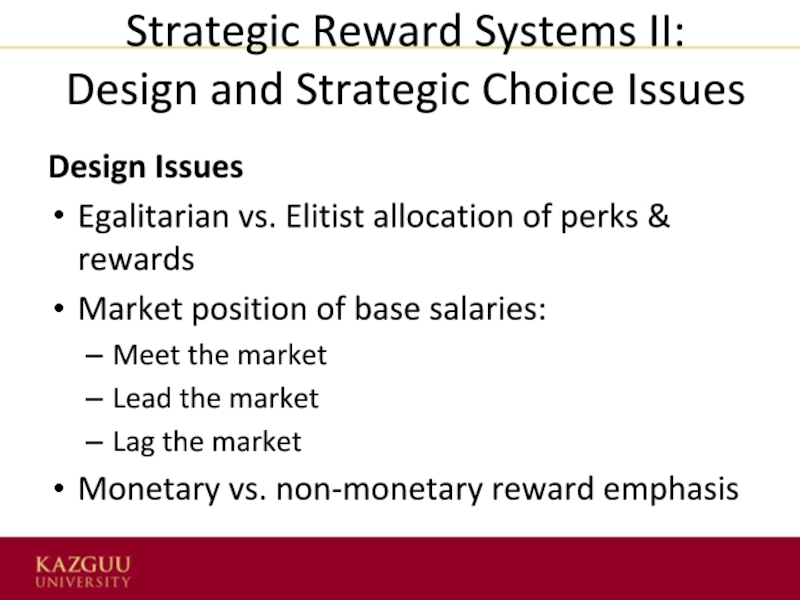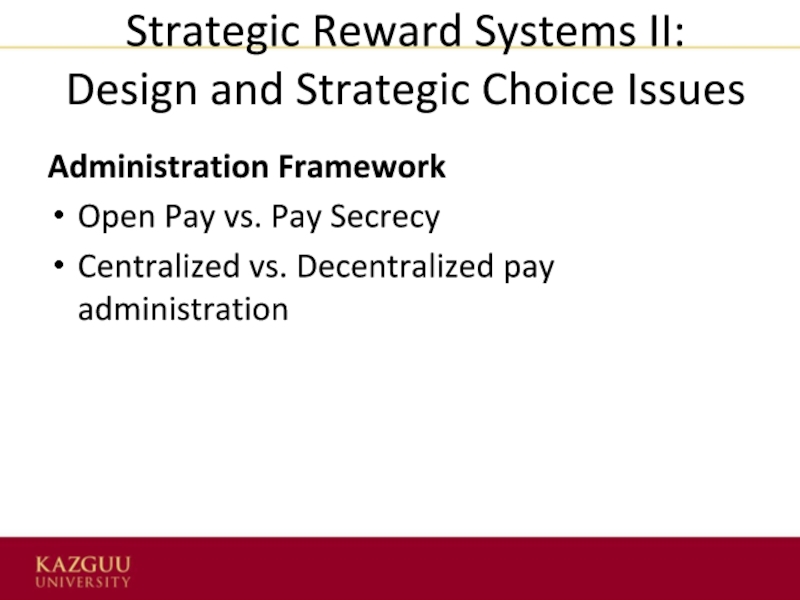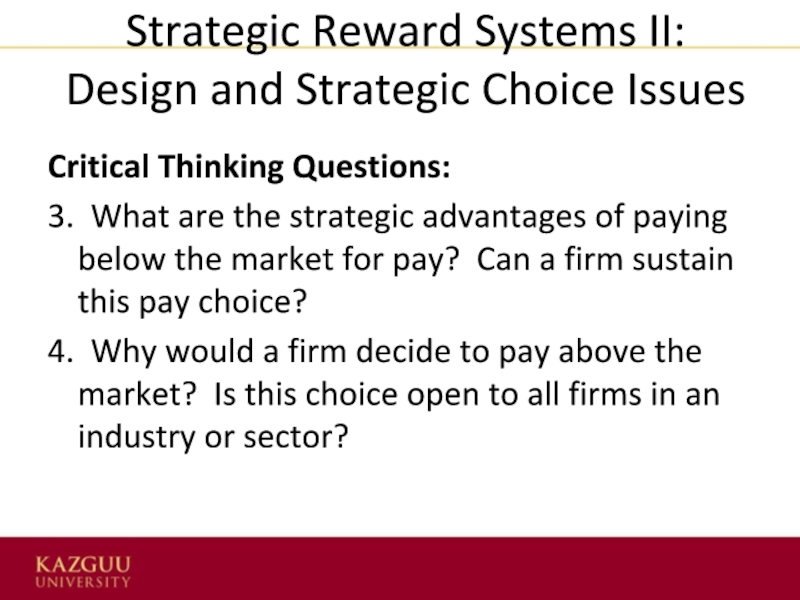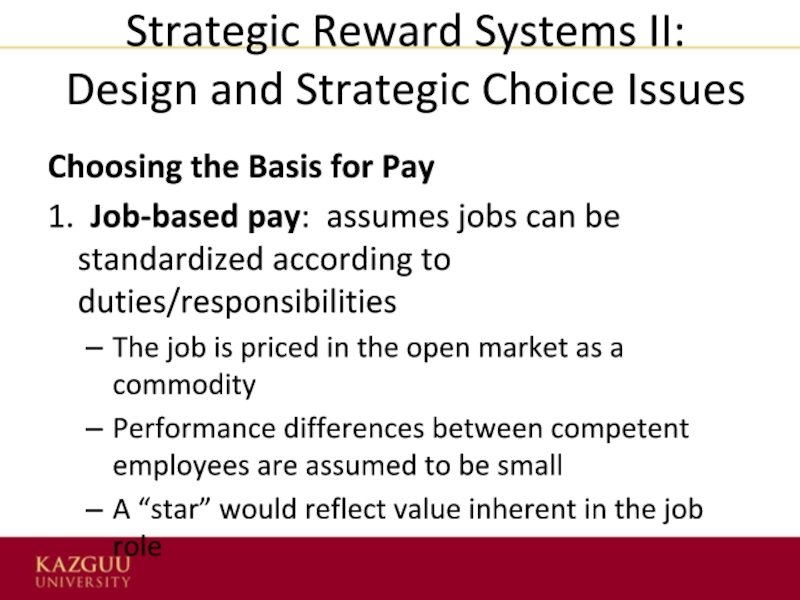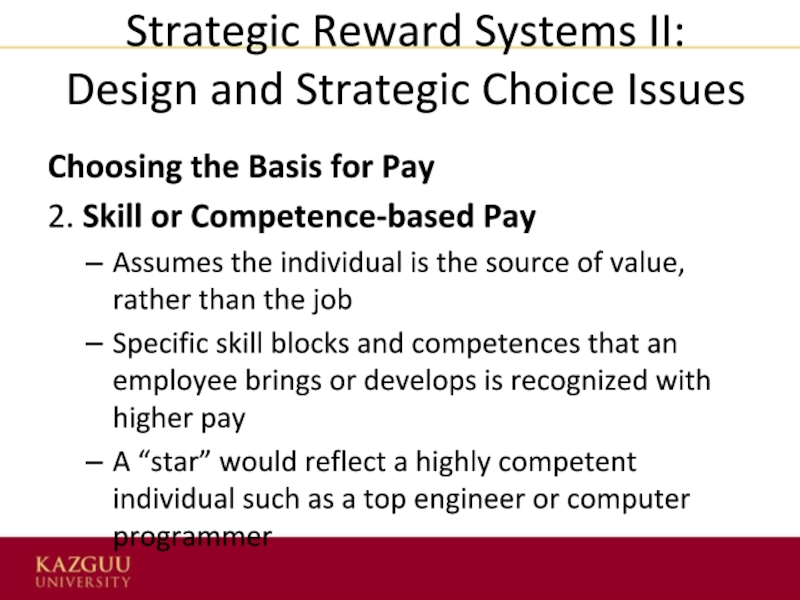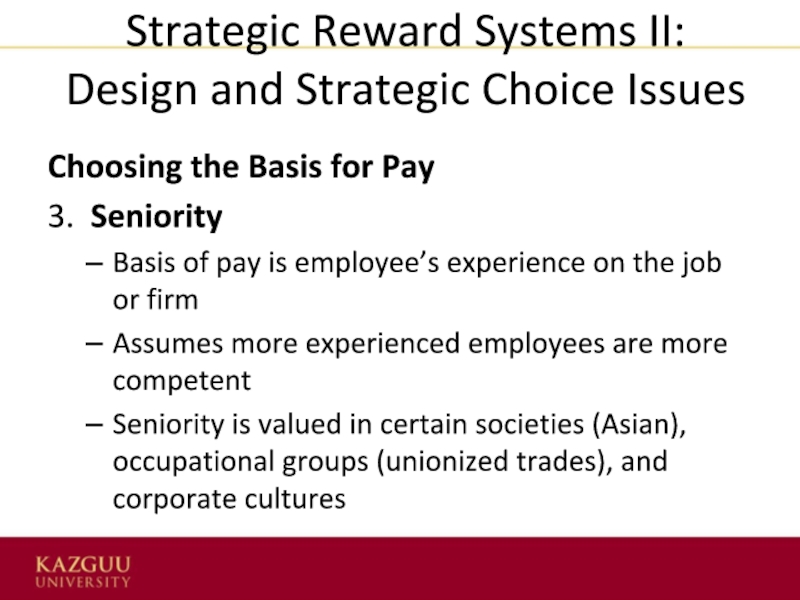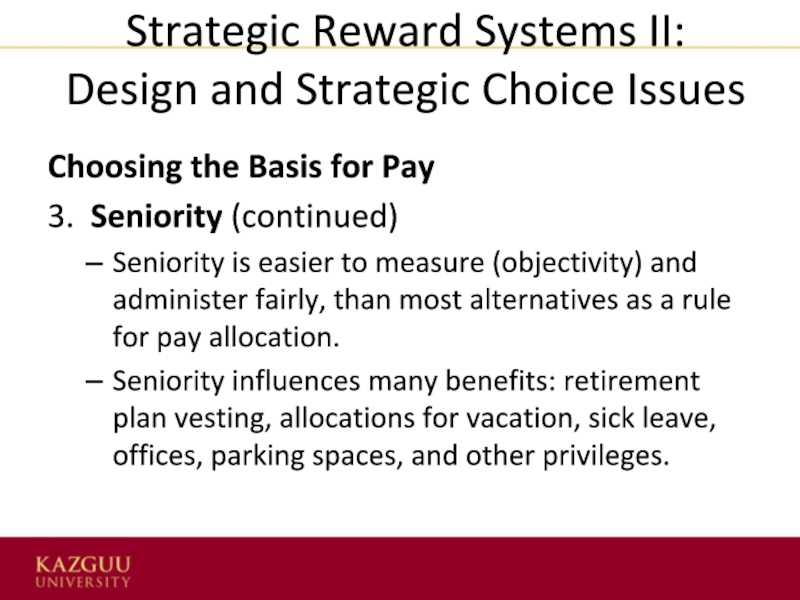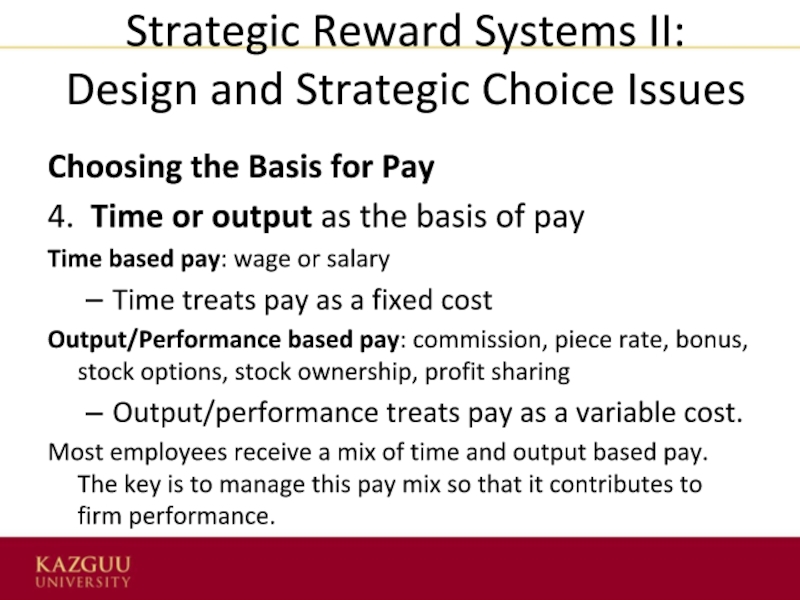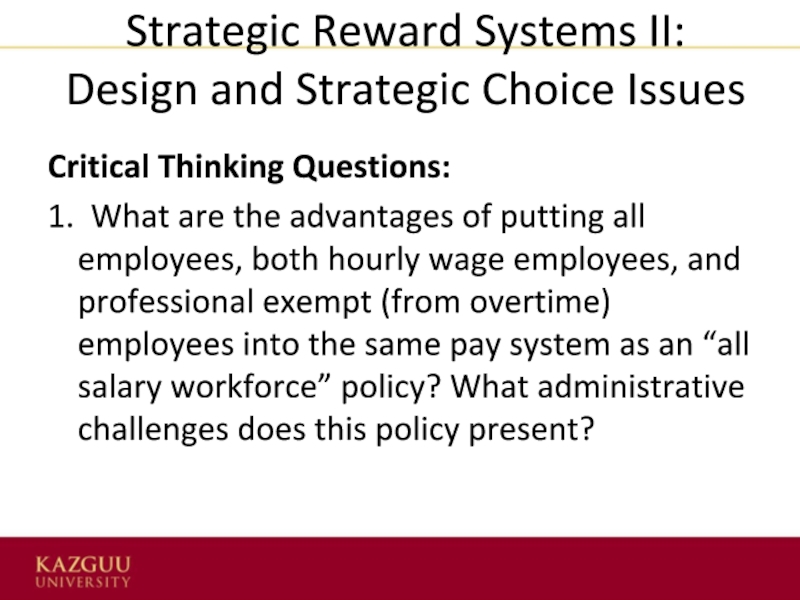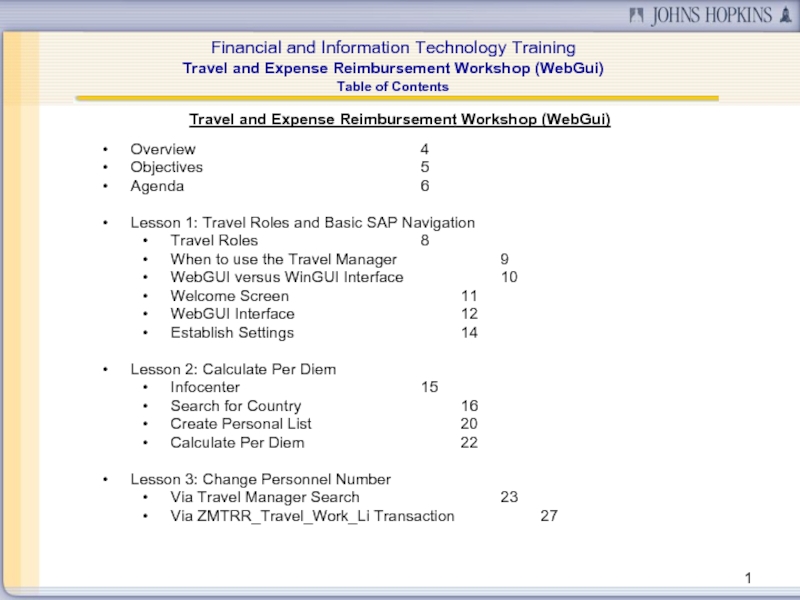- Главная
- Разное
- Дизайн
- Бизнес и предпринимательство
- Аналитика
- Образование
- Развлечения
- Красота и здоровье
- Финансы
- Государство
- Путешествия
- Спорт
- Недвижимость
- Армия
- Графика
- Культурология
- Еда и кулинария
- Лингвистика
- Английский язык
- Астрономия
- Алгебра
- Биология
- География
- Детские презентации
- Информатика
- История
- Литература
- Маркетинг
- Математика
- Медицина
- Менеджмент
- Музыка
- МХК
- Немецкий язык
- ОБЖ
- Обществознание
- Окружающий мир
- Педагогика
- Русский язык
- Технология
- Физика
- Философия
- Химия
- Шаблоны, картинки для презентаций
- Экология
- Экономика
- Юриспруденция
Strategic Reward Systems презентация
Содержание
- 1. Strategic Reward Systems
- 2. Strategic Reward Systems II: Design and
- 3. Strategic Reward Systems II: Design and
- 4. Strategic Reward Systems II: Design and
- 5. Strategic Reward Systems II: Design and
- 6. Strategic Reward Systems II: Design and
- 7. Strategic Reward Systems II: Design and
- 8. Strategic Reward Systems II: Design and
- 9. Strategic Reward Systems II: Design and
- 10. Strategic Reward Systems II: Design and
- 11. Strategic Reward Systems II: Design and
- 12. Strategic Reward Systems II: Design and
- 13. Strategic Reward Systems II: Design and
- 14. Strategic Reward Systems II: Design and
Слайд 2Strategic Reward Systems II:
Design and Strategic Choice Issues
Basic goals of
a compensation system
Attract employees
Retain employees
Motivate employees
Compliance with pay laws
Administrative simplicity
Cost effectiveness
Attract employees
Retain employees
Motivate employees
Compliance with pay laws
Administrative simplicity
Cost effectiveness
Слайд 3Strategic Reward Systems II:
Design and Strategic Choice Issues
Critical Thinking Questions
1.
Which goals would be most critical for a technology company such as Visionary Design Systems?
2. Which goals would be most critical for a non-profit company?
2. Which goals would be most critical for a non-profit company?
Слайд 4Strategic Reward Systems II:
Design and Strategic Choice Issues
Design Issues
Job-based vs.
Individual-based pay design
Fixed vs. Variable pay
Internal vs. External pay equity emphasis
Performance vs. Membership as basis for rewards
Fixed vs. Variable pay
Internal vs. External pay equity emphasis
Performance vs. Membership as basis for rewards
Слайд 5Strategic Reward Systems II:
Design and Strategic Choice Issues
Design Issues
Egalitarian vs.
Elitist allocation of perks & rewards
Market position of base salaries:
Meet the market
Lead the market
Lag the market
Monetary vs. non-monetary reward emphasis
Market position of base salaries:
Meet the market
Lead the market
Lag the market
Monetary vs. non-monetary reward emphasis
Слайд 6Strategic Reward Systems II:
Design and Strategic Choice Issues
Administration Framework
Open Pay
vs. Pay Secrecy
Centralized vs. Decentralized pay administration
Centralized vs. Decentralized pay administration
Слайд 7Strategic Reward Systems II:
Design and Strategic Choice Issues
Critical Thinking Questions:
1.
Why do most private firms choose to have a pay secrecy policy? Do they work? Does pay secrecy fit with a high commitment HR system where employee participation is a strong element of corporate culture?
2. Should a manager receive higher pay than the subordinates that she/he supervises?
2. Should a manager receive higher pay than the subordinates that she/he supervises?
Слайд 8Strategic Reward Systems II:
Design and Strategic Choice Issues
Critical Thinking Questions:
3.
What are the strategic advantages of paying below the market for pay? Can a firm sustain this pay choice?
4. Why would a firm decide to pay above the market? Is this choice open to all firms in an industry or sector?
4. Why would a firm decide to pay above the market? Is this choice open to all firms in an industry or sector?
Слайд 9Strategic Reward Systems II:
Design and Strategic Choice Issues
Choosing the Basis
for Pay
1. Job-based pay: assumes jobs can be standardized according to duties/responsibilities
The job is priced in the open market as a commodity
Performance differences between competent employees are assumed to be small
A “star” would reflect value inherent in the job role
1. Job-based pay: assumes jobs can be standardized according to duties/responsibilities
The job is priced in the open market as a commodity
Performance differences between competent employees are assumed to be small
A “star” would reflect value inherent in the job role
Слайд 10Strategic Reward Systems II:
Design and Strategic Choice Issues
Choosing the Basis
for Pay
2. Skill or Competence-based Pay
Assumes the individual is the source of value, rather than the job
Specific skill blocks and competences that an employee brings or develops is recognized with higher pay
A “star” would reflect a highly competent individual such as a top engineer or computer programmer
2. Skill or Competence-based Pay
Assumes the individual is the source of value, rather than the job
Specific skill blocks and competences that an employee brings or develops is recognized with higher pay
A “star” would reflect a highly competent individual such as a top engineer or computer programmer
Слайд 11Strategic Reward Systems II:
Design and Strategic Choice Issues
Choosing the Basis
for Pay
3. Seniority
Basis of pay is employee’s experience on the job or firm
Assumes more experienced employees are more competent
Seniority is valued in certain societies (Asian), occupational groups (unionized trades), and corporate cultures
3. Seniority
Basis of pay is employee’s experience on the job or firm
Assumes more experienced employees are more competent
Seniority is valued in certain societies (Asian), occupational groups (unionized trades), and corporate cultures
Слайд 12Strategic Reward Systems II:
Design and Strategic Choice Issues
Choosing the Basis
for Pay
3. Seniority (continued)
Seniority is easier to measure (objectivity) and administer fairly, than most alternatives as a rule for pay allocation.
Seniority influences many benefits: retirement plan vesting, allocations for vacation, sick leave, offices, parking spaces, and other privileges.
3. Seniority (continued)
Seniority is easier to measure (objectivity) and administer fairly, than most alternatives as a rule for pay allocation.
Seniority influences many benefits: retirement plan vesting, allocations for vacation, sick leave, offices, parking spaces, and other privileges.
Слайд 13Strategic Reward Systems II:
Design and Strategic Choice Issues
Choosing the Basis
for Pay
4. Time or output as the basis of pay
Time based pay: wage or salary
Time treats pay as a fixed cost
Output/Performance based pay: commission, piece rate, bonus, stock options, stock ownership, profit sharing
Output/performance treats pay as a variable cost.
Most employees receive a mix of time and output based pay. The key is to manage this pay mix so that it contributes to firm performance.
4. Time or output as the basis of pay
Time based pay: wage or salary
Time treats pay as a fixed cost
Output/Performance based pay: commission, piece rate, bonus, stock options, stock ownership, profit sharing
Output/performance treats pay as a variable cost.
Most employees receive a mix of time and output based pay. The key is to manage this pay mix so that it contributes to firm performance.
Слайд 14Strategic Reward Systems II:
Design and Strategic Choice Issues
Critical Thinking Questions:
1.
What are the advantages of putting all employees, both hourly wage employees, and professional exempt (from overtime) employees into the same pay system as an “all salary workforce” policy? What administrative challenges does this policy present?

